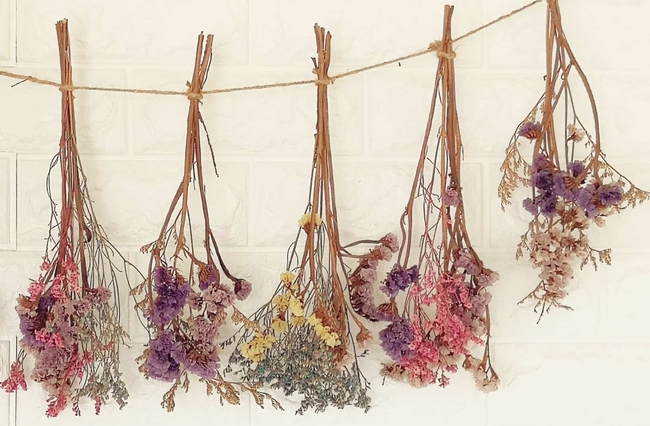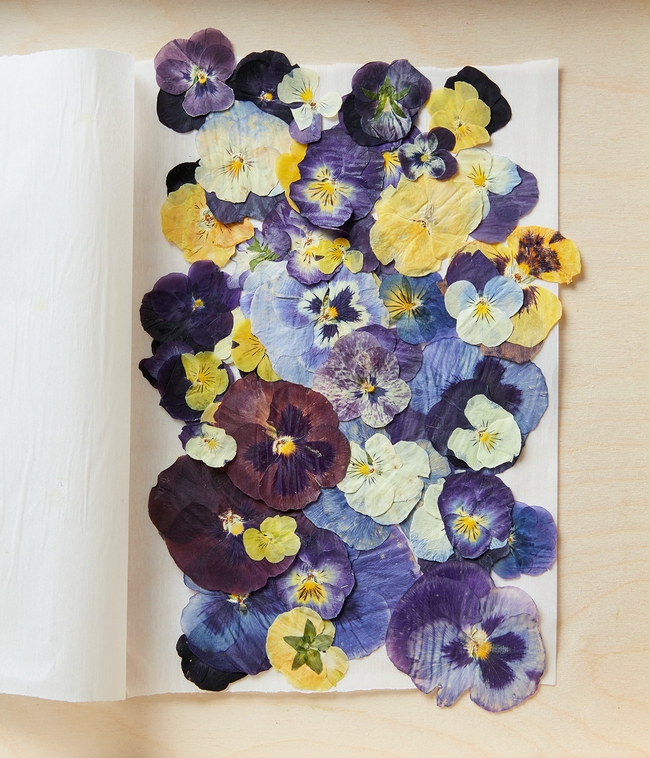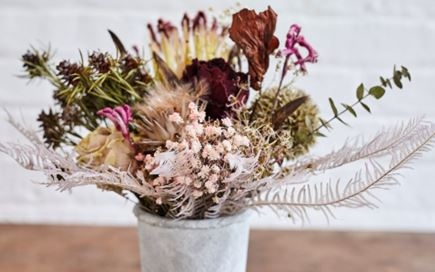Preserving flowers is an easy and enjoyable way to extend their life. There are a number of ways to accomplish this; here are a few:
Hanging flowers upside down to dry is a simple method that keeps the stems straight so the flowers can be displayed in a vase. Flowers with low moisture content, particularly everlasting flowers--which are those composed of colorful, papery bracts--dry very successfully. Some examples are cockscomb (Celosia cristata), (strawflower Xerochrysum bracteatum), baby's breath (Gypsophilia spp.), yarrow (Achillea millefolium), and blazing star (Liatris spp.).
Lavender and rose buds can also be dried this way.
For best results:
- Cut the stems just above a leaf or leaf pair before flowers are fully open in the morning after the dew has dried.
- Discard any bruised, damaged, or imperfect flowers and inspect for insects.
- Remove the leaves.
- Make small bundles held with rubber bands--which will contract as the stems shrink--bunching them loosely to discourage mold.
- Hang them to dry in a dark, warm, dry place with good air circulation, keeping them out of direct sunlight to avoid fading the colors.
Dried flowers can be used for arrangements and should last about a year.
This tried and true method is suitable for foliage and simple flowers with a few petals that will look attractive when flat, such as ferns, violets or daisies. It requires just a few inexpensive materials:
- Start with a book-sized piece of cardboard.
- Lay a folded sheet of newspaper on it, and cover that with tissue paper.
- Lay the flowers on tissue paper, being sure they don't touch.
- Cover with another sheet of tissue paper, more newspaper, and another layer of cardboard.
- More layers can be added to accommodate more flowers.
- When finished, place a heavy book on top of the stack and add weight with a rock or a brick for good measure.
The flowers should be ready in 2-4 weeks and can be used for various crafts: notecards, gift tags, or framed arrangements. They can even be attached to candles with a bit of melted wax.
Drying flowers with silica gel
Silica gel, which is actually a granular desiccant, can be used to dry flowers such as anemones, larkspur, pansies and even hydrangeas. It requires an initial investment--about $12 for a 1 ½ pound tub--and but the silica gel can be reused and recharged in the oven at 300 degrees when it is no longer effective, indicated by the crystals turning from blue to pink. Follow the directions and precautions on the product; these are general directions:
- Place about an inch of silica gel on the bottom of a container that is not used for food and lay the flowers on it, face up, with space between them.
- Cover completely with another layer of silica gel, allowing the granules to fall into the spaces between the petals.
- Seal the container for 3-5 days.
- To speed the drying process, microwave the unsealed container for a minute or two on low power, stopping to check them at least every 30 seconds.
- This requires some trial and error; fewer flowers with more delicate petals require a shorter time than larger flowers with a higher moisture content.
- Let the silica gel cool before gently lifting out the flowers; carefully shake off or brush off the excess crystals.
These pansies took 2 minutes to dry at 50% power in a 1000-watt microwave, as did the single ranunculus.
One advantage of this method is that it helps preserve the color of the flowers, but they can also be damaged by microwaving for too long or at a high wattage.
Silica gel drying is also a good method for preserving a wedding bouquet, which requires a few more steps:
- Photograph the bouquet for future reference.
- Disassemble the bouquet and cut the stems, leaving about 2 inches intact.
- Dry the flowers as described above.
- When dry, pierce the stems with lengths to floral wire and wrap them in floral tape to create new stems.
- Reassemble the bouquet, using the photo as a guide.
Part of the appeal of flowers is their fleeting nature, but it can be rewarding and fun to extend their lives and enjoy them longer.




